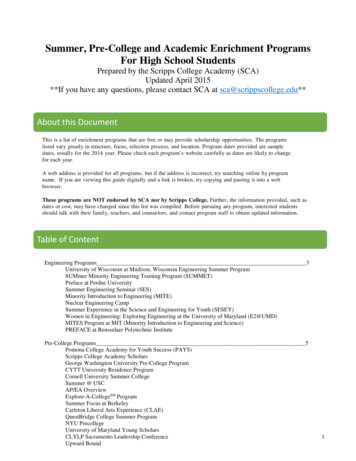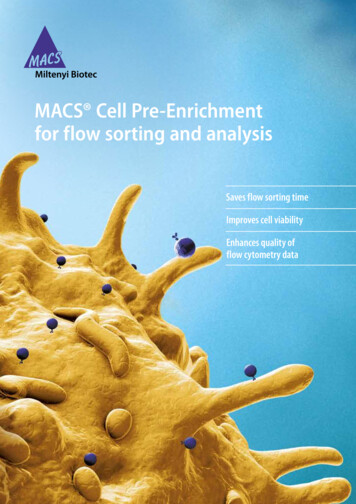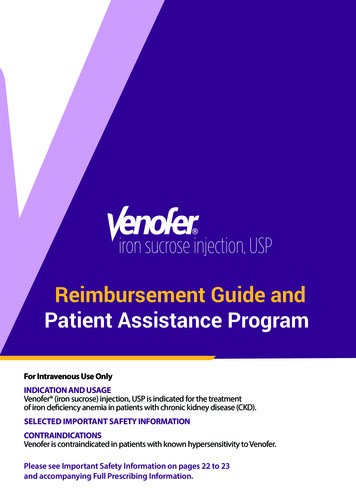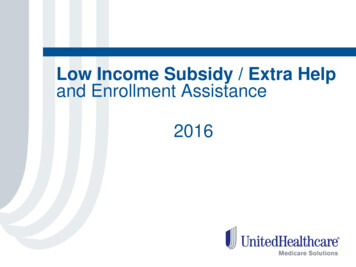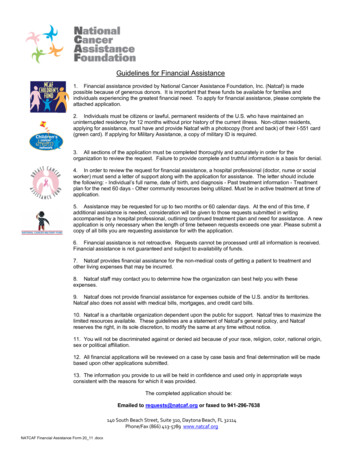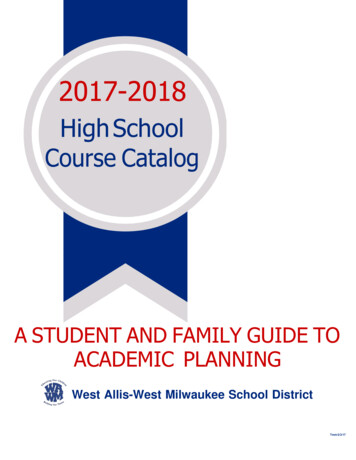
Transcription
2017-2018High SchoolCourse CatalogA STUDENT AND FAMILY GUIDE TOACADEMIC PLANNINGWest Allis-West Milwaukee School DistrictTmm/2/3/17
1
TABLE OF CONTENTSSECTION I: High School OverviewSCHOOL BOARD . . 3PUBLIC NOTICE PUPIL NONDISCRIMINATION. 3PURPOSE OF THE STUDENT AND FAMILY GUIDE TO PROGRAM PLANNING . . . 3CONTACT INFORMATION . 4GRADUATION REQUIREMENTS . 5GRADE POINT CALCULATION METHOD. 5GUIDELINES FOR HIGH SCHOOL COURSE SELECTION . 5HIGH SCHOOL REQUIREMENTS PLANNING SHEET . 6SCHEDULE CHANGES AND COURSE DROPS . 6NATIONAL COLLEGIATE ATHLETIC ASSOCIATION (NCAA) REQUIREMENTS . 7TESTING .8ACCOMMODATING VARYING STUDENT NEEDS AND ABILITIES . 9CAREER/TECHNICAL EDUCATION POST SECONDARY PROGRAMS . 9ADVANCED PLACEMENT COURSES . 9ELECTIVE COURSES . 9PROJECT LEAD THE WAY . 10TRANSCRIPTED CREDIT . 10SECTION II: Career PathwaysCAREER PATHWAYS: The WA-WM Comprehensive Student Services Model . 12THE SIXTEEN CAREER CLUSTERS . 13WORK-BASED LEARNING OPTIONS . 30CAREER MAJOR INTERNSHIP . 30SECTION III: Course DescriptionsART . 32BUSINESS AND MARKETING EDUCATION . 35COMPUTER SCIENCE .39ENGLISH LANGUAGE ARTS/READING . 40FAMILY, CONSUMER, and HEALTH SCIENCE . 45MATHEMATICS . 50MUSIC . 53PHYSICAL EDUCATION . 56SCIENCE . 60SOCIAL STUDIES. . 64TECHNOLOGY AND ENGINEERING . 68WORLD LANGUAGE . 73ADDITIONAL COURSES AND OPPORTUNITIES . 76INDIVIDUAL EDUCATION PLAN (IEP) COURSES . 78ELECTIVES AND PERSONALIZED LEARNING. 80WAWM LEARNING CENTER COURSE OFFERINGS. 812
SECTION I: HIGH SCHOOL OVERVIEWWest Allis-West Milwaukee School DistrictSCHOOL BOARDDaniel BaileyStephanie EmonsHeather JusthamPatricia J.KerhinDiane NarlockGail RadonskiJeff SikichSue SujeckiBill UstruckDr. Marty LexmondSuperintendentPUBLIC NOTICE PUPILNONDISCRIMINATIONThe School District of West Allis-W est Milwaukee, et al. is committed to equal educational opportunity for allstudents. It is the policy of the School District of West Allis-West Milwaukee, pursuant to s. 118.13, WisconsinStatutes, and PI 9, that no person, on the basis of sex, race, religion, color, national origin, ancestry, creed,pregnancy, marital or parental status, sexual orientation, or physical, mental, emotional, or learning disability orhandicap, may be denied admission to any school in this district or be denied participation in, be denied thebenefits of, or be discriminated against in any curricular, extra-curricular, pupil services, recreational, or otherprogram or activity. This policy also prohibits discrimination as defined by Title IX of the Education Amendments of1972 (sex), Title VI of the Civil Rights Act of 1996 (race, color, and national origin), Section 504 of the FederalRehabilitation Act of 1973, and the Americans with Disabilities Act of 1990 (Disability).The district encourages informal resolution of complaints under this policy. A formal complaint resolution procedureis available, however, to address allegations of violations of the policy in the School District of West Allis-W estMilwaukee, et al.Any questions concerning this policy should be directed to:Dr. Marty Lexmond, SuperintendentWest Allis-West Milwaukee School District1205 South 70th StreetWest Allis, WI 53214(414) 604-3005Any questions concerning Section 504 should be directed to:Ann Locke, Manager of Student ServicesWest Allis-West Milwaukee School District1205 South 70th StreetWest Allis, WI 53214(414) 604-3016PURPOSE OF THE STUDENT AND FAMILY GUIDE TO PROGRAM PLANNINGThe purpose of this guide is to provide parents and students with a catalog of the courses that make up the curriculum so that theycan cooperatively plan for the four years of high school. Parents are encouraged to retain this guide for use throughout the highschool years. By projecting a tentative plan for the four years, parents and students can anticipate a sequence of courses thatwill provide the best possible program for individual needs and goals following high school. The student is not obligated to adhereto the program plan for four years. It is always open to modification dependent upon changing interests and achievement.The school district will attempt to offer those courses listed in this guide. However, please note, all courses may not beoffered each semester or on an annual basis. Certain changes need to be made each year in order to adhere to thecourse offering guidelines, which consider the number of students interested in particular courses, staff availability, andscheduling parameters. Each high school will send out an approved (by Department of Instructional Services) course offeringlisting each year that students will be able to use for scheduling purposes. This list will contain all the courses available thatyear (subject to course enrollment parameters).Parents may contact the school principal to review the teaching materials that will be used in any of the courses. If there arequestions or concerns, the principal and parent will discuss possible solutions.3
CONTACT INFORMATIONThe following people are involved in guiding and assisting students and parents with high school planning:Student Services604-3070Instructional Services604-3015Central High SchoolAmy Van DeurenToby SchwartzKailey LuhrNate RiceToby Schwartz604-3100Principal, Central High SchoolStudent Services PersonnelStudent Services PersonnelStudent Services PersonnelStudent Services PersonnelNathan Hale High School 604-3200Matthew LesarPrincipal, Nathan Hale High SchoolBrandi AnthonyStudent Services PersonnelJessica PremoStudent Services PersonnelKarin HoustonStudent Services PersonnelNikki LevineStudent Services PersonnelGail ReisenauerStudent Services PersonnelFrank Lloyd Wright Intermediate School 604-3400Jeff ThomsonPrincipal, Frank Lloyd Wright Intermediate SchoolSabrina BartelsStudent Services PersonnelNicholas BurStudent Services PersonnelKatie McGrathStudent Services PersonnelLane Intermediate School 604-4200Bob AntholinePrincipal, Lincoln Intermediate SchoolKyle MalinStudent Services PersonnelChristine PiotrowskiStudent Services PersonnelLincoln Intermediate School 604-4200Liz KayzarPrincipal, Lincoln Intermediate SchoolHeather CloseStudent Services PersonnelWest Milwaukee Intermediate School 604-3300Jeff TaylorPrincipal, West Milwaukee Intermediate SchoolSteve KorbStudent Services PersonnelKory HigginsStudent Services Personnel4
EXPECTATIONS FOR COHORT CREDIT ATTAINMENTA student must be enrolled for four (4) full school years in grades 9, 10, 11, and 12 to meet the graduationrequirements. He/she must have completed all requirements earning a total of 23.5 credits for graduationbefore receiving a high school diploma.Classification of all students will be determined according to a students’ chronological year in high school. Tobe on track to graduate with your cohort (graduating class), all students are expected to earn aminimum of 6.00 credits per year or be subject to mandatory summer school.Graduating Class of 2017 to 2019Year 1 (Freshman Year)Year 2 (Sophomore Year)Year 3 (Junior Year)Year 4 (Senior Year)Graduating Class of 2020 & Beyond6.00 credits12.00 credits18.00 credits23.50 creditsYear 1 (Freshman Year)Year 2 (Sophomore Year)Year 3 (Junior Year)Year 4 (Senior Year)GRADE POINT CALCULATION METHODGradeA AAB BBC CCD 0 credits12.00 credits18.00 credits24.00 credits
WAWM High School Requirements Planning Sheet for Graduating Class 2017 to 201923.5 Total CreditsSuccessful completion of the following subject and credit requirements4 Credits including:English English 9AB/Honors English 9 (1.0)English 10AB/Honors English 10 (1.0)English11AB (1.0)/ American Literature (1.0)/AP Language and Composition(1.0)/AP Literature and Composition (1.0)World Literature (1.0)/AP Language and Composition (1.0)/AP Literature and Composition(1.0) or English electives totaling 1.0 credit3 Credits:Math (1.0) (1.0) (1.0)3 Credits including: Biology and a Physical Science is required by Department of PublicInstructionScience ththBiology/Honors Biology (1.0) (9 or 10 grade)Physical Science or Chemistry/Honors Chemistry (1.0) or Physics/AP Physics (1.0)Science electives totaling 1.03 Credits including:Social Studies Modern U.S. History (1.0) or AP Human Geography (1.0)World History (1.0) or AP World History (1.0)U.S. Government and Politics (.50) or AP U.S. Government and Politics (1.0)Social studies elective (.50)1.5 Credits including:Physical Education(Only 1 PE course per yearwill count toward thisrequirement- others may betaken and are counted aselective credit) Essentials of Physical Activity-9 (.50)10thth- 12 Grades electives totaling 1.0 credit(.50)(.50).5 CreditHealth Health (.50)8.5 Credits from any course that is not taken to meet one of the above requirements ElectivesCredits Required for Graduation23.50The district reserves the right to schedule students for on-line learning course(s) for the purpose of creditrecovery due to failure or when class enrollment does not meet minimal class size.6
ATTENTION STUDENT ATHLETESNATIONAL COLLEGIATE ATHLETIC ASSOCIATION (NCAA) REQUIREMENTSThe NCAA is the governing body for intercollegiate (between colleges/universities) athletics, just like theWisconsin Interscholastic Athletic Association (WIAA) governs athletic competition between high schools. Mostcolleges and universities also offer intramural sports, just like the WAWM Recreation Department offersintramural sports. College and university intramural sports are not governed by the NCAA, just like WAWMRecreation Department intramural sports are not governed by WIAA.At the college and university level, there are three divisions of intercollegiate athletics:Division I (Marquette, UW-Green Bay, UW-Madison, UW-Milwaukee)Division II (UW-Parkside)Division III (Carroll University, MSOE, UW-La Crosse, UW-Whitewater, etc.)The NCAA has minimum academic eligibility standards that students must meet in order to participate andreceive a grant-in-aid (scholarship) for athletic participation during their first year of attendance at Division I &Division II schools. Division III schools do not have initial academic eligibility requirements.PLEASE NOTE: An individual college or university’s admission requirements will likely be morerigorous/competitive than the NCAA minimum standards. Therefore, students and families should review therespective admission requirements for each school they are considering for school-specific admission requirements.To participate in and be eligible for an athletic grant-in aid (scholarship) during a student athlete’s first year ofattendance, s/he must meet the following minimum standards:Division I: 16 core credits**4.0 English3.0 mathematics (Algebra 1 or higher)2.0 natural/physical science1.0 Additional English, math, or science2.0 social science/studies4.0 Add. from above areas, foreignlanguage, or comparativereligion/philosophyDivision II: 16 core credits***3.0 English2.0 mathematics (Algebra 1 or higher)2.0 natural/physical science3.0 Additional English, math, or science2.0 social science/studies4.0 Add. from above areas, foreignlanguage, or comparativereligion/philosophy** To be eligible to participate and receive a Division I athletic scholarship in first year, the NCAAalso requires a minimum grade point average (GPA) of 2.300 in those 16 core courses listedabove, a minimum college admission test score (ACT or SAT) that matches core-course GPA, andthat the student graduates high school. The NCAA sliding scale for competition can be applied toGPA and ACT/SAT. To learn about these requirements, visit www.eligibilitycenter.org, call 877262-1492, or speak to Student Services personnel.*** To be eligible to participate and receive Division II athletic scholarship in first year, the NCAAalso requires a minimum grade point average (GPA) of 2.200 in those 16 core courses listedabove, a minimum college admission test score (ACT or SAT) that matches core-course GPA, andthat the student graduates high school. The NCAA sliding scale for competition can be applied toGPA and ACT/SAT. To learn about these requirements, visit www.eligibilitycenter.org, call 877262-1492, or speak to Student Services personnel.7
State-Mandated Assessments –The West Allis-West Milwaukee School District administers the state-mandated Wisconsin Student Assessment System (WSAS) testing program.These results provide valuable information regarding student strengths and interests that can be used in planning a course of study.Below is a chart of tests/assessments your student may be taking during their high school years.AssessmentDescriptionStandard AlignmentPopulationSubject AreasAdministration WindowDynamic Learning Maps (DLM)Alternative assessment for students withsignificant intellectual disabilitiesCommon Core Essential Elements3-12Subject Specific SkillsPre-Academic SkillsCommunication SkillsAttention SkillsMarch – MayAspireA pre-college readiness system thatmeasures academic readiness for college.The test uses the same score scale asACT to monitor academic progress andgrowth.Common Core/ACT Benchmarks9, 10EnglishReadingMathScienceGrade 9, 10: MayACT plus WritingA college readiness assessment thatassesses students’ academic readiness forcollege.Common Core/ACT Benchmarks11EnglishMathReadingScienceGrade 11: MarchWork KeysA job skills assessment system that is partof ACT Work Readiness system that helpsstudents compare their skills to the skillsreal jobs requireACT National Career Readiness11Applied MathematicsReading for InformationLocating InformationGrade 11: MarchAccessMeasure of English language proficiencyEnglish Language DevelopmentStandards (ELD)ELL StudentsReading, WritingListening, SpeakingDecember - FebruaryA computer adaptive assessment used toprovide on-going achievement updates toplan instruction and measure studentgrowthCommon CoreK - 10ReadingMathFall:: September/OctoberWinter: December/JanuarySpring: March/April11th gradeCollege ReadinessOctoberDistrict AssessmentMAPOptional AssessmentPSAT/NMSQTCollege Readiness and National MeritScholarship Qualifying Test8
ACCOMMODATING VARYING STUDENT NEEDS, INTERESTS, AND ABILITIESTo accommodate students with different needs and different rates of learning, the school district provides avariety of course levels in addition to the regular courses in some selected basic skill areas such as Reading,English Language Arts, and Mathematics. These levels can be described as follows:1. Special Education courses are adapted for students who have identified disability conditions and specialeducation needs which require an Individual Educational Plan.2. Intervention courses provide reading, writing and mathematics skill development. Students are placed in thiscourse based on academic performance levels.3. Honors courses are geared to those students whose skill level is such that they can benefit from a broader ormore intensive and in-depth study.4. Weighted courses are approved for weighted grade status. A chart of grade points for the regular andweighted scales is found on page 6. The Board approves weighted courses.5. Advanced Placement (AP) courses prepare students for AP exams. These courses offer an opportunity forstudents to earn college credit in high school. By completing college-level courses and earning a score of 3or more points on a 5 point scale on the AP exam, students may earn college credit, stand out in the admissionprocess, and learn from highly skilled AP teachers.More than 90 percent of four-year colleges in the United States and colleges in more than 60 other countriesgive students credit, advanced placement
WAWM LEARNING CENTER COURSE OFFERINGS.81 . 3 SECTION I: HIGH SCHOOL OVERVIEW Daniel Bailey Stephanie Emons Heather Justham West Allis-West Milwaukee School District SCHOOL B

